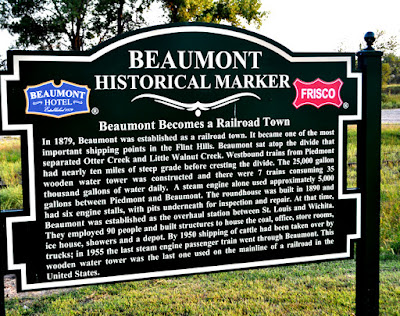ST. LOUIS - SAN FRANCISCO (FRISCO) RAILWAY CO.
No railroad tracks existed in Kansas until 1860 when the Elwood and Marysville line, five miles of track, was constructed opposite St. Joesph, Missouri.
Soon, over fifty railroads were chartered by the territorial legislature and the race was on. Railroads competed for the acquisition of land from the Federal Government and from the Indians who then lived in the state of Kansas.The eventual goal of most, if not all of the railroads, was to complete a more southern route across the United Sates to the west coast. The Pacific Railroad surveys recommended a Kansas route "to avoid the snows of the north and the heat of the southern desert." The disadvantage was that the railroads had to deal with the resistance of Indian tribes to allow railroads access to their lands. Eventually, the Union Pacific Railroad would join in completing a transcontinental railroad with its route through Nebraska.

Beaumont, Kansas was a railroad town, established in 1879, serving as layover for the St. Louis - San Fransico Railway Company, better known as the Frisco, on its route between Ft. Scott, at the eastern edge of Kansas, and Wichita. The ATSF built a route just to the north which passed through Eureka and El Dorado on its way to Wichita.
The name St. Louis - San Francisco, like many other railroad names, represented a dream and not reality; the railroad began in St. Louis and ended in Texas just west of Fort Worth, and, in Kansas to Ellsworth and Abilene.
Visit
the Frisco for images and information. Look at some old
postcards from the Frisco. Image of Engine 1522 by Darrel Drumm, taken in Arkansas City.
The Frisco was incorporated in 1876 and was formed out of the assets of the defunct Atlantic and Pacific Railroad . In Kansas the Frisco competed against the larger and more successful Atchinson, Topeka, and Santa Fe Railroad (ATSF), which succeeded in crossing Kansas with track by 1873 and connecting to Pueblo, Colorado by 1876. A second railroad, the Missouri Pacific ran a line from Ft. Scott to Eureka and Wichita, north of the Frisco line through Beaumont.
Perhaps because the success of the ATSF, the Frisco, between the years 1872 and 1880, focused on building a connecting line, the St. Louis, Wichita and Western, connecting the town of Pierce City on the Frisco main line to Wichita, Kansas, where it joined the main line of the Santa Fe.
Later, in 1884 there began a series of extensions of the Frisco, and construction was started at Beaumont, Kansas in 1885 routing through Latham and Winfield, Kansas reaching Gale on the Kansas - Oklahoma border February 1, 1886.
See the full map which is a part of the collection from the
Wichita State University Libraries.
The full extent of the Frisco Railroad in Kansas is described in William G. Cutler's
History of the State of Kansas, first published in 1883.
The Kansas Division of the St. Louis & San Francisco Railway enters Kansas in Cherokee County and runs westerly through the counties of Cherokee, Labette, Montgomery, Wilson, Elk (northeast corner), Greenwood and Butler, to Wichita, Sedgwick County, distance 171 miles. The branches in Kansas are from Joplin, Mo., to Girard, Kan. (thirty-eight miles - twenty in Kansas); from Oronogo, Mo., to Galena, Kansas (twenty miles - two miles in Kansas); and from Litchfield Junction to Litchfield, Crawford County, 2.50 miles. Total number of miles in Kansas, 195.50.

The Frisco employed 90 workers at Beaumont, which served as a refueling stop, as well as a railroad staging area for shipping cattle from the Flint Hills. The rich Kansas Blue-stem grass and local water reservoirs allowed Beaumont to hold 9,000 cattle at one time. Beaumont was less famous for cattle shipping as other staging areas at Ellsworth and Abilene gathered more attention.
The Frisco "All Aboard" provides a gathering place for railroad enthusiasts who have information or questions about the Frisco.
The land around Beaumont was settled during the homesteading movement following the Civil War.But Beaumont did not come into its own until in 1885, when Beaumont was established as the overhaul station for the Frisco between St. Louis and Wichita and five rows of tracks at Beaumont handled the daily four eastbound and four westbound trains.
The Beaumont Water Tower, built in 1885, stands across from the Beaumont Hotel. It is the only one still standing in the United States, and is listed on the National Register of Historic Places. The former roundhouse, built in 1890 had six engine stalls for repair and inspection. Altogether the railroad employed 90 people for its operations. Dr. William J. Phillips was the town doctor.
Read more about the
Frisco Railroad.
The Beaumont Hotel, which is still in existence, was originally known as the Summit Hotel as Beaumont was the highest point on the Frisco Line from Wichita, Kansas to St. Louis, Missouri.
Guests at the hotel included cattle barons from Texas and Oklahoma and the elite of the Frisco Railroad. Beaumont served as headquarters for those who shipped or brought cattle in to fatten on the mineral rich grasses of the Flint Hills. While cattle barons and ranchers relaxed in the hotel, cowboys camped outside. Nearby were two water reservoirs and holding pens for 9,000 head of cattle.









